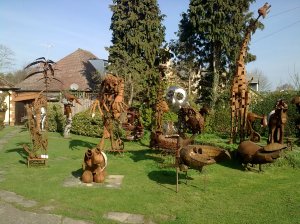20th August 2010, the tenth day of Ramadan. Windy days draw me out, and today is such a day. It is fine and dry with a strong warm wind coming out of the west – a kite-flying day, if I had one. At any one time a thousand separate clouds, equidistant from each other, all at the same height above ground, and all more or less the same size and shape, process steadily across a huge sky. Above them are stationery schools of mackerel clouds and gorgeous swirls of cirrus set in deep luminous blue. Between the running cloud-islands the sun pools down on the land, polishing every surface. The wind ebbs and surges, bowing the smaller trees and churning through the copses and woods. From a distance it really does sound like the sea.
The fine weather has brought out the heavy machinery. In the distance a tractor is dragging a disc harrow, slowly and systematically painting the dull earth a uniform rich cinnamon-brown and trailing a wake of white gulls. How do they know? How do they know that the earth will be opened today? Only very occasionally this summer have I seen gulls passing by, and then just in ones and twos. Now two dozen have materialized out of nowhere. Perhaps they smell it. The air is saturated with the odour of freshly-turned earth.
Butterflies are about again, after the wet weeks – mostly Large Whites though I come across one rather battered Painted Lady, orange and black with white-spotted wing-tips, the only one of this species I’ve seen this year. Migrating from the Middle East and North Africa they sometimes mass in their millions across Britain. Not so this year, not here. But today dragonflies abound. I see them everywhere, near and far from water. They glide effortlessly, it seems, without wing movement, until, against the light, you see their four transparent gossamer wings a-quivering at the very edge of perception.
I come across two dead rabbits, fairly fresh still and whole, with no obvious cause of demise. Then, on three separate occasions, a rabbit blunders towards me, blind and disoriented, eyes puffed, red, oozing puss. Myxomatosis. There is no known cure for this deliberately-introduced plague, first observed in laboratory rabbits (surprise, surprise), except long-term genetic resistance. Death takes, on average, 14 days.
On a happier note I discover another section of the old medieval track hedged with wild plum bushes laden with fruit – round red cherry plums, oval orange-yellow mirabelles and ox-blood red bullaces. For me these wild plums have been a real discovery this year – far superior to any supermarket plum, delicious raw or stewed, and abundant across the district. I pick several kilos of sweet cherry plums and mirabelles and throw in a few handfuls of sloes for bite, to be savoured later at fast-breaking time.
There are few birds about, except woodpigeons who seem to relish the wind, and a party of some dozen wittering swallows who ply back and forth over a bean-field. I sit by a field-gate and watch them for ten minutes or so. They swoop low along the edge of the field, in the shelter of a hedge, and when they reach the gate opening and the brunt of the wind they flick upwards and over, twisting back for the home run, all the while making small noises. When I stand up they fly within a few feet of my head.
I walk home with a bag of wild plums at my wrist, an exhilarating wind in my face, and the world all around me in motion.




